Ribadeo (1597)
Miguel San Claudio, Ana Crespo, Nigel Nayling, Arnaud Cazenave de la Roche, and Filipe Castro
Follow this project on facebook, Ainhoa López Formadela‘s webpage .
Sponsored by
![]() Institute of Nautical Archaeology * Galician Port Authority * Galician Cultural Heritage administration * Spanish Navy * Royal Yacht Club Ribadeo * Ribadeo’s Galleon Friends Association * ForSEAdiscovery (EU Grant agreement no.: 607545) * Ayuntamiento de Ribadeo
Institute of Nautical Archaeology * Galician Port Authority * Galician Cultural Heritage administration * Spanish Navy * Royal Yacht Club Ribadeo * Ribadeo’s Galleon Friends Association * ForSEAdiscovery (EU Grant agreement no.: 607545) * Ayuntamiento de Ribadeo
Introduction
In 1597 Spain ruled over a large empire that extended around the entire world. King Philip II and his court were extremely organized and developed a bureaucracy that today allows scholars to reconstruct the life of the empire year by year.
A large portion of Anglo-Saxon history – mostly in the US – has been written, however, by scholars that have not studied the Spanish reality and insist in selling a so-called ‘Black Legend,” which is ham-handed and often times borders racism, repeating 16th-Century English propaganda as historical truth.
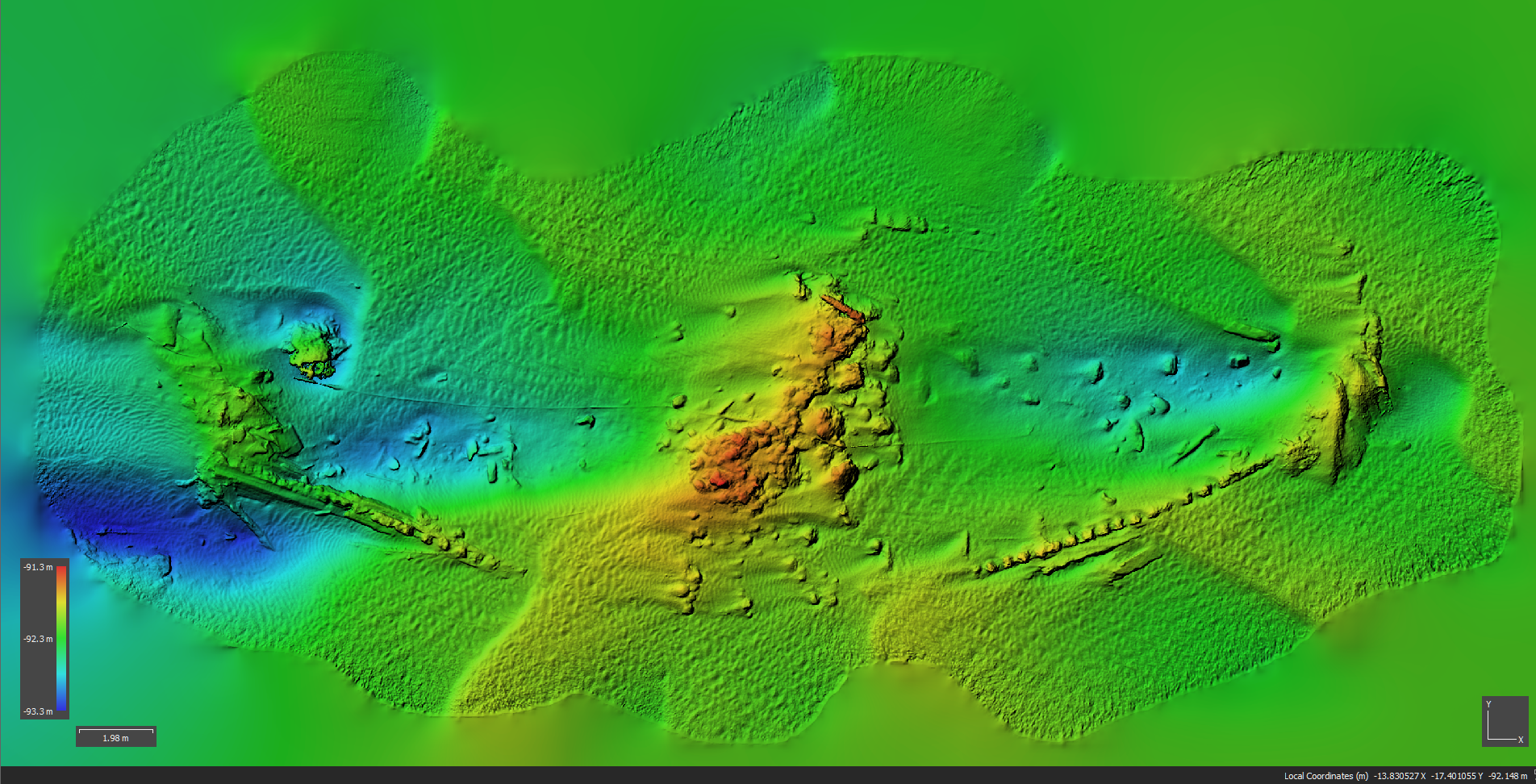
Extremely well-preserved, Santiago de Galicia appeared to us as a good pretext to talk about Spanish 16th-Century history in a more objective manner, and Project Director Miguel San Claudio chose an international team to investigate this site and its history.
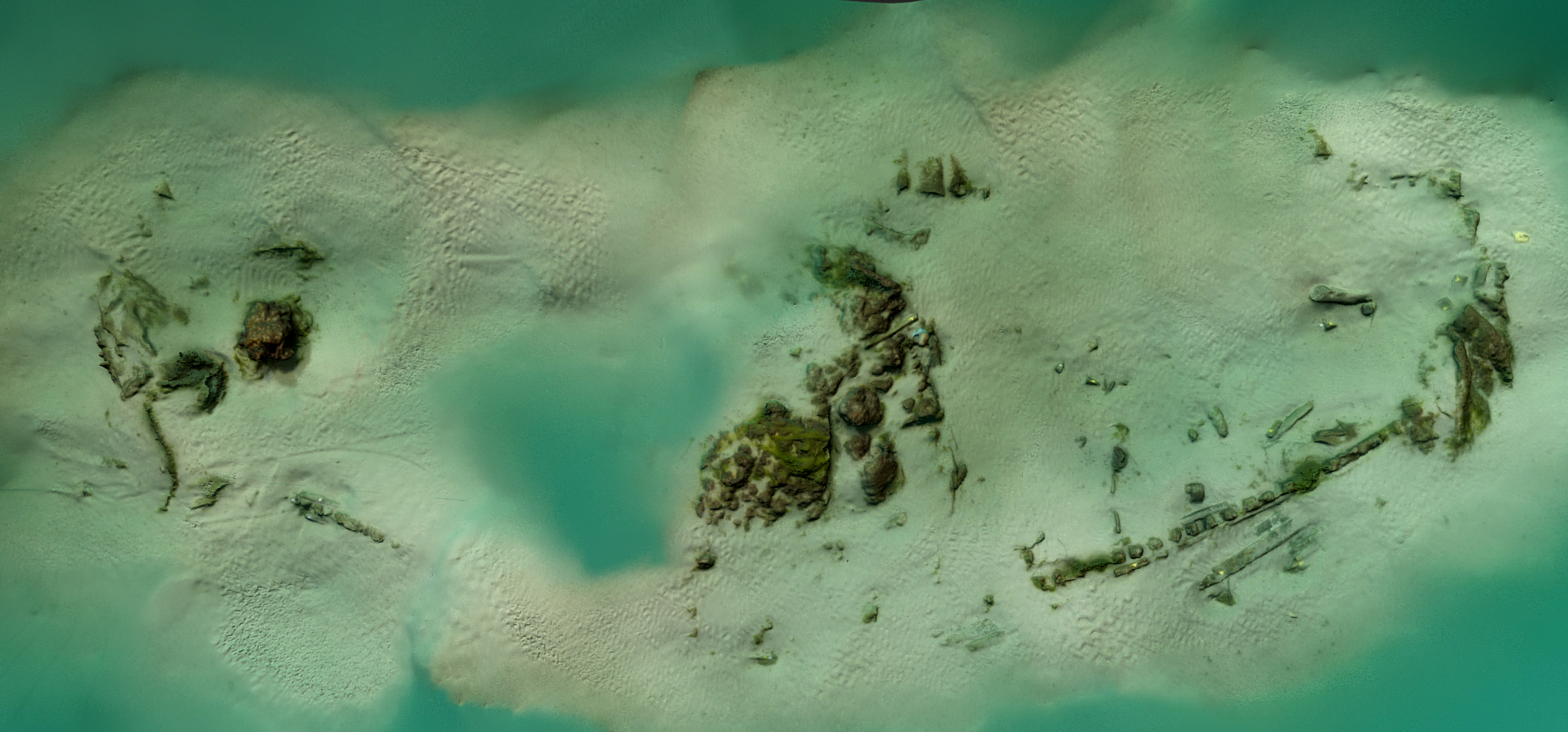
Fig. 2 – Pre-disturbance photogrammetry of the site by Brandon Mason and Christine Heamagi, from the Maritime Archaeology Trust (2015).
Santiago de Galicia was a warship built for one of the most powerful monarchs of the world in its time, and as such it stands as a good example of the Empire’s shipbuilding standards. Financed by a Ragusan merchant and built in Italy, near Napoli, this ship was designed by some of the best shipwrights of its time. It was part of a second set of galleons designated as “The Apostles,” built to secure the Atlantic routes from pirates and privateers, and protect the uninterrupted flow of wealth that poured previously unimaginable fortunes into Spain, from the four corners of the World.

Even though we have secured the support of several institutions, including the regional government and the Spanish Navy, and in 2019 we were granted support by the Institute of Nautical Archaeology (INA), this project is a low-budget project and this circumstance encouraged us to propose a study of the ship, its story, excavation and reconstruction, and a meta-study, on how to maximize the cooperation of all the disciplines and share our discoveries, theories, mistakes, and corrections in real time, and hopefully involve a larger community and include the feedback from the interested public.
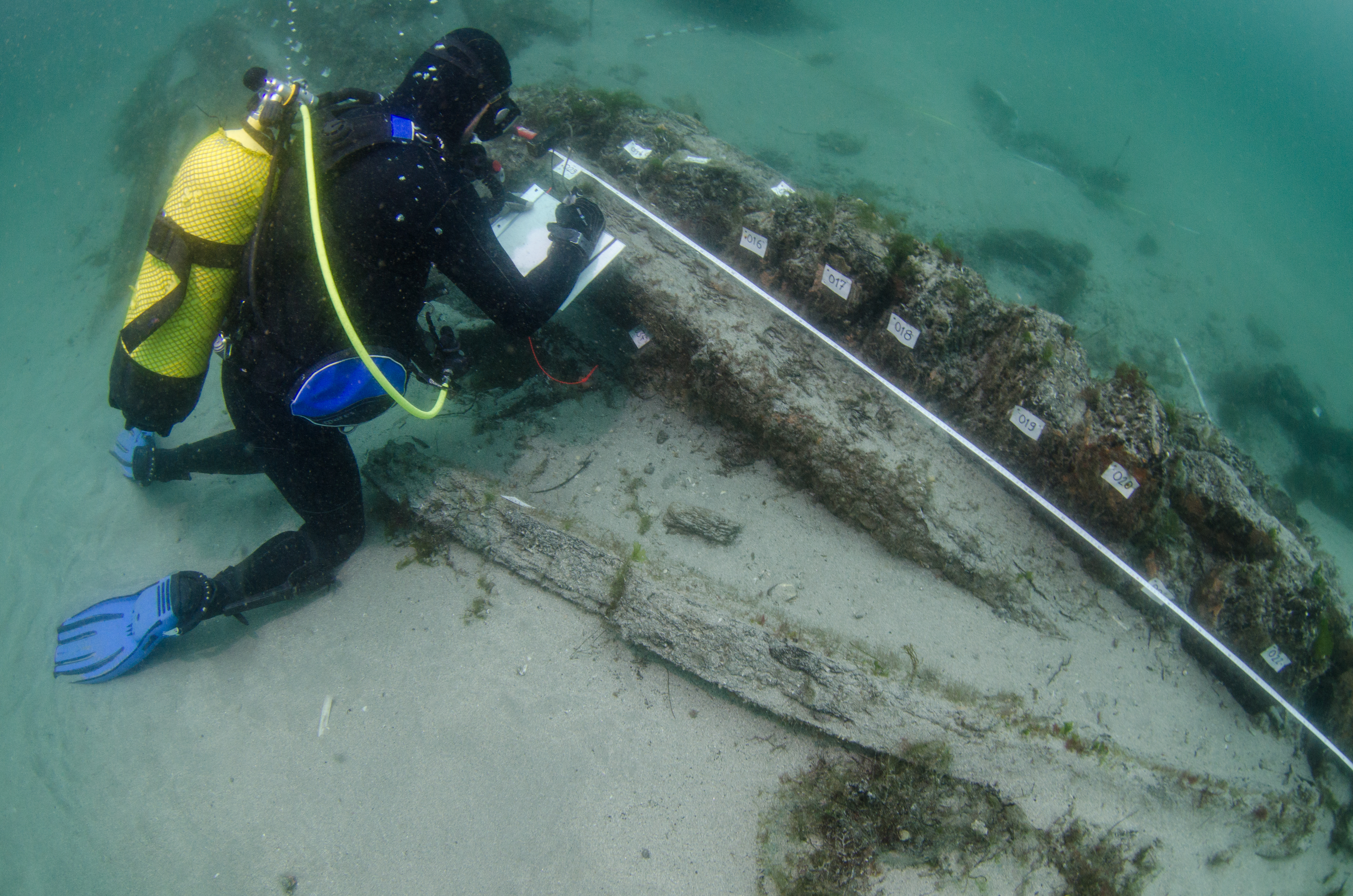
The community is an important component of this project and we work hand in hand with the local association El Galeon de Ribadeo.
Given the fact that Santiago de Galicia is a unique example of a Mediterranean warship from the 16th century, and that this is a critical period in the development of the modern world, we are certain that this ship is a testimony to particularly creative stage of the development of naval warfare and deep sea navigation of its time.
We have only a small number of archaeological examples of warships from this period built in the north of Europe, but none from the Iberian Peninsula, and none from the Mediterranean, where we believe the warships of the 16th century were first developed.
Technical documents on shipbuilding appear in this period, but they don’t describe Italian-built warships in any detail. All we have are sets of measurements that give us an idea of the ship size, but not of its shape of structural design.
Our research strategy will focus on twelve separate tasks:
- Archaeology: pending the availability of funds, we intend to excavate this shipwreck site by strategically located trenches, to record the ship structure in detail, together with the hull shape;
- Iconography: we will develop a database of ship images that may plausibly represent ships of this type;
- History: we will gather, inventory, and summarize all the existing documentation pertaining to the construction and operation of Santiago de Galicia;
- Computer graphics: we will develop a series of computer graphics tools selected in order to facilitate the testing of reconstruction hypothesis:
4.1. A set of chronologically organized orthophotographs of the site, from 2011 onward;
4.2. A set of chronologically organized 3D meshes of the site
4.3. Lines drawings of:
4.3.1. the Pepper Wreck;
4.3.2. Caetano Hormaechea proposal with a round midship section;
4.3.3. Caetano Hormaechea proposal with a flat on the floor;
4.3.4. A set of lines drawings developed from Lomelina’s timbers;
4.3.5. A set of lines drawings developed from the Calvi 1 timber drawings.
5. A number of sections extracted from the meshes;
6. A number of vertical orthophotos of the surfaces exposed (e.g. Area 1, Trench 2.1, Trench 2.2, etc.);
7. A set of drawings for publication, including a site plan, a view of the interior of the hull on Trench 2.2., two orthogonal sections of Trench 4;
8. A set of 3D hypothetical reconstructions of the timbers exposed, total or partially;
9. Reconstruction 3D models combining the meshes (4.2.) and 3D renderings of the timbers exposed (8.);
10. Reconstruction 3D models combining the meshes (4.2.) and the hypothetical lines drawings (4.3.).
11. A timber catalogue, preferably organized as a database.
12. An artifact catalogue, preferably organized as a database to be connected with a GIS database.
Team
The team currently engaged in the investigation of this shipwreck encompasses a large number of disciplines and is too large to be fully described here.
Miguel San Claudio, archaeologist, principal investigator.
Ana Crespo, historian.
Nigel Nayling, archaeologist and specialist in dendrochronology.
Arnaud Cazenave de la Roche, archaeologist.
Filipe Castro, archaeologist.
Christin Hemaegi, archaeologist, specialist in photogrammetry.
Brandon Mason, archaeologist, specialist in photogrammetry.
Evan Fray, archaeology student, University of Wales Trinity St. Davis.
Ricardo Borrero, archaeologist, PhD student at Texas A&M University.
The Spanish Navy team included the following participants:
Pablo
Angel
Story of the Ship
Santiago de Galicia was built in the Kingdom of Naples, a constituent part of the Spanish Empire until 1713. Its captain and owner, Giovanni di Polo, assisted in its construction at Castellammare de Stabia, directed by master Colela Bonifacio, a native of Naples. La Almiranta de Ivella, the second ship in command of the fleet, as it was also known, was one of the twelve great galleons of the Ilírian Squadron of Pedro de Ivella.
As part of the 1597 Armada against England, it saw action and battled the weather in the later months of that year and was beached. The Spanish forces gathered at Ferrol in 1596, under the command of Martin de Padilla, Adelantado de Castilla and Diego Brochero second in command. There were Spanish, Portuguese, French, Danish, Scottish, German, Flemish, Venetian, and Italian ships in the fleet, which encompassed 15 galleons from the crown and nine galleons from Portugal, 53 urcas from Germany and the Low Countries, six patachos, and 15 caravels. A second Armada joined this one from Vigo, encompassing 41 ships under the command of Pedro de Zubiaur: 25 navios of 100-400 toneladas, and 16 pinazas.
It was a large ship for its time: 33.43 m long and approximately 11.42 m in beam. On September 28, 1595, in Lisbon, the ship was assigned 1,349 tons and a 138 crew of seamen, who were joined by two companies of soldiers. Despite the traditional idea that these large ships only had wind propulsion, we know that part of the ships of the Ilírica squadron had sweeps, powered by several men. Surviving papers document the payment of 5,612 maravedies for 4 oars, for the galleon’s use. If these were not for an auxiliary boat, they could be for the galleon’s propulsion.
Artillery
Santiago de Galicia was a very well-built ship and enjoyed consideration among contemporary sailors. It was chosen because of its conditions to transport most of the money of the expedition. It carried 28 pieces of artillery, 16 pieces of which, in bronze, were the property of its owner, from a Genoese foundry.
According to a relation made in Lisbon on September 23, 1595, the 16 pieces owned by the ship’s proprietor were:
|
Tipo |
Calibre (libras) |
Peso |
|
|
1 |
Medio cañón |
20 |
42 quintales y 58 rotulos de Génova |
|
1 |
Medio cañón |
20 |
42 quintales y dos rotulos |
|
1 |
Sacre |
8 |
13 quintales y 90 rotulos de Nápoles |
|
1 |
Sacre |
8 |
13 quintales y 90 rotulos de Nápoles |
|
1 |
Medio sacre |
4 |
14 quintales y 22 rotulos de Génova |
|
1 |
Medio sacre |
4 |
14 quintales y 22 rotulos de Génova |
|
1 |
Pedrero |
8 |
<<Sin número de peso>> |
|
1 |
Pedrero |
8 |
<<Sin número de peso>> |
|
1 |
Pedrero |
7 quintales y 68 rotulos de Génova |
|
|
1 |
Pedrero |
7 quintales y 68 rotulos de Génova |
|
|
1 |
Pedrero |
14 |
9 quintales y 79 rotulos de Génova |
|
1 |
Pedrero |
14 |
9 quintales y 90 rotulos |
|
4 |
Esmeriles |
2 |
40 rotulos de Nápoles |
Crew
On November 20, 1593, Santiago de Galicia‘s crew was officially 120 men, among sailors, gunners and officers. We know the names of 37 of them throughout the history of the ship, although not all of them were on the ship at the same time, nor were they necessarily on board at the time of the shipwreck.
Men, like ships and their artillery, are a repertoire of the territories controlled by the Hispanic monarchy and its allies:
|
Nombre |
Cargo |
Origen (estimado) |
|
Juan de Polo |
Armador / Capitán |
Ragusa |
|
Colela Bonifacio |
Constructor |
Nápoles |
|
Mateo Letiela (Latiela) |
Capitán |
Italia |
|
Marcolin de Juan |
Capitán |
España |
|
Tomás Blanco |
Capitán |
España |
|
Russio de Apoforo |
Piloto |
|
|
Francisco Tançi |
Maestre |
|
|
Pompeo del Fino |
Cirujano |
Italia. Estuvo presente en el naufragio |
|
Vicencio Jiraldino |
Capellán |
|
|
Marino de Antonio |
Capellán |
Estuvo presente en el naufragio |
|
Joan Marnabich |
Ragusa |
|
|
Juan de Herónimo |
Marinero |
|
|
Juan Bauptista Campi |
Maestre de raciones |
|
|
Juan de Salbator |
Guardián |
|
|
Bartolomé Ordisoni |
Tonelero |
Italia |
|
Esteban de Nicolo |
Alguacil del agua |
Italia |
|
Rado de Marino |
Marinero |
Ragusa |
|
Nicolas de Estephano |
||
|
Andrea de Reco |
||
|
Nicolo de Antonio |
Italia |
|
|
Julio de Pedro |
España |
|
|
Jorge de Marco |
||
|
Estefano de Luque |
España |
|
|
Pero Balbaych |
Ragusa |
|
|
Pedro de Miguel |
||
|
Juan Domingo |
||
|
Juan de Pª |
Italia |
|
|
Vocho Santi |
||
|
Marco de Jorge |
||
|
Claudio Salomon |
Grumete |
|
|
Galio de Franqui |
Italia |
|
|
Elia de Luca |
Italia |
|
|
Rado de Juan |
Italia |
|
|
Pedro Mendiola |
España |
|
|
Juan Miguel |
Artillero |
España |
|
Esteban de Florio |
Artillero |
Italia |
Loss
This ship was lost in November 1597. After arriving in Cornwall, the 1596 fleet was again pushed back by bad weather and was forced to retreat to the Iberian Peninsula, due to strong winds. The wind and sea conditions dispersed the ships and most returned separately to the safety of Spanish harbors. During the return, the galleon Santiago de Galicia had to fight alone against a fleet of four ships, three Flemish and one English.
When the news of the withdrawal of the naval fleet arrived in Spain, there was much concern about the fate of Santiago de Galicia, transporting a large sum of 91,000 escudos. Soon there were news, however, of the arrival of the galleon at Ribadeo, with two transport hulks (urcas), battered by the bad weather, but safe. With the crew and treasure in safety in early November, the ship was deemed too broken to be repaired and was beached and salvaged.
Ribadeo received sailors and soldiers with dignity and generosity, the city council ordered to village to bake bread to feed sailors and soldiers and housed them safely in houses and warehouses.
Despite all this support, the galleon Santiago de Galicia was not safe in the port of Ribadeo. Shortly before November 13, 1597, he ran aground inside the estuary on a sandbank. The people of the galleon were saved, as were the 91,000 ducats it carried.
We do not know the specific reason for the wreck that, due to the disposition of the wreck, occurred while the tide was rising. Probably the weight of the boat, due to the strong current of the tide, made the anchors drag. If so, the phrase of its owner, Giovanni di Polo, who blamed the loss of his ship on the “bad governor government …” may make sense. This Ragusan shipowner estimated the losses from the shipwreck of his ship at 40,000 ducats.
After the shipwreck, the rescue work began on everything that could be used by the wrecked ship. The shallow depth allowed the rescue of artillery, rigging and “other debris”. With all this, Giovanni di Polo proposed to the king on February 7, 1598 that he allow him to manufacture another galleon.
Find
historically been a very active port. Maritime traffic has left a rich submerged archaeological record, attesting an intense commercial activity of the port at least since the Middle Ages.
The deposit was located on November 2011 during the archaeological assessment of dredging operations in the Ribadeo estuary. Previously, an archaeological survey had been carried out by divers, together with a bathymetric study of the area. The shipwreck was not detected in both surveys the wreck, being completely buried in the sand.
On November 28, at a point of great hardness, about 5m deep, the dredge’s suction arm extracted several stone fragments, a wooden board and a lead sheet. Since the stones did not correspond to the local geology, Miguel San Claudio deduced that they could be part of a ship’s ballast.
Lead lining of ships has been used since Roman times, with an increase in the early sixteenth century. This use disappeared in the second half of the 18th century when copper sheathing was introduced. According to the objects obtained from the dredge, the archaeologists concluded that these were the remains of a ship from before the 19th century.
The next day, a couple of divers were sent down, and verified the existence of the wreck of a large wooden ship. The ceramics observed on the wreck referred San Claudio to a Spanish origin of the ship and a chronology from the end of the 16th century.
The dredging was interrupted at this point allowing the preservation of the site and beginning its study.
Site Formation Process
The site formation process is not easy to reconstruct at this point of the project, but it is expected that the King’s men salvaged all they could before abandoning the derelict to its fate, in the estuary. Marine life and the strong tide currents must have done the rest.
The is a layer of fine grey silt under the sand layer that covers the site. In some points there are pockets of dark, organic sediment, and the structure’s periphery shows signs of destruction by marine life.
Although the ship was relatively young, some timbers in the lower hull show teredo-like damage, suggesting that the lower hull was not immediately covered with sediment.
Tumulus
The site exposed consisted of an area measuring approximately 40 x 20 m, where a large hull structure seems to be buried at least 2 m deep.
The mound of sand that covers the wreck is affected by the strong tidal current, which can reach three knots of speed. The sand moves with the current, covering and uncovering different areas of the ship. Over time the exposure of the lower layer, formed by an organic sludge, jeopardized the conservation of the many objects it contains. The timbers of the ship’s structure are also intermittently exposed, compromising its conservation. The action of living beings on the structure and wooden objects is a factor of alteration.
Ballast
The ballast is one of the most striking elements of the deposit, it is medium-sized limestone, located in the central part of the wreck. There are also numerous boulders, quartzite, in addition to gravel of volcanic origin. All these materials have a geological origin in the surroundings of the Gulf of Naples and the volcanic stones specifically come from the Vesuvius volcano, located very close to Castellammare di Stabbia, the shipyard where Santiago de Galicia was built.
Lowering the center of gravity of a vessel is essential to its stability. The balance of weights determines the safety and efficiency of sailing ships. It can be made up of different heavy elements such as iron ingots, cannons, but especially stones, gravel and sand were used in this case. Most of the central pile consists of large pebbles, 15 to 35 cm in size.
Ship Fittings
Anchors
The ship dragged its anchors during the process of running ashore, pushed by the rising tide. So far no anchor has been located. We believe that all anchors were salvaged when the ship was beached at Ribadeo.
Guns and Armament
The number and type of the guns carried aboard Santiago de Galicia are indicated above. As with the anchors, all guns must have been salvaged from this derelict. A gun carriage wheel was exposed in 2019.
Other
No other fittings have been exposed so far.
Hull Remains
The ship’s hull remains are preserved over a large area, and may encompass a large portion of the port side, conserved far above the turn of the bilge.
Scantlings
We have documents that state the basic dimensions of this ship:
Built in Napoli (Castellammare di Stabia) by Colea Bonifacio.
Keel 44.5 codos = 25.59 m (1 codo = 0.575 m)
Beam 20.5 codos = 11.79 m
Length overall 60 codos = 34.50 m
Flat of the floor 7.5 codos = 4.31 m
Depth in hold 13.5 codos = 7.76 m
Entries 2 codos = 1.15 m
Runs 7.5 codos = 4.31 m
Largo en Puente 64 codos = 36.80 m
If the stem is tangent to the keel (1/4 circle):
Length of the stem 13.5 codos
& 60 (LOA) – 13.5 – 44.5 = 2 codos = rake of the sternpost
Rake of the sternpost = puntal / 6.75
Description
As after the 2019 field season, the hull remains consist of a structure of floor timbers and first, and perhaps second futtocks, with a heavy outer planking and extremely thick inner planking.
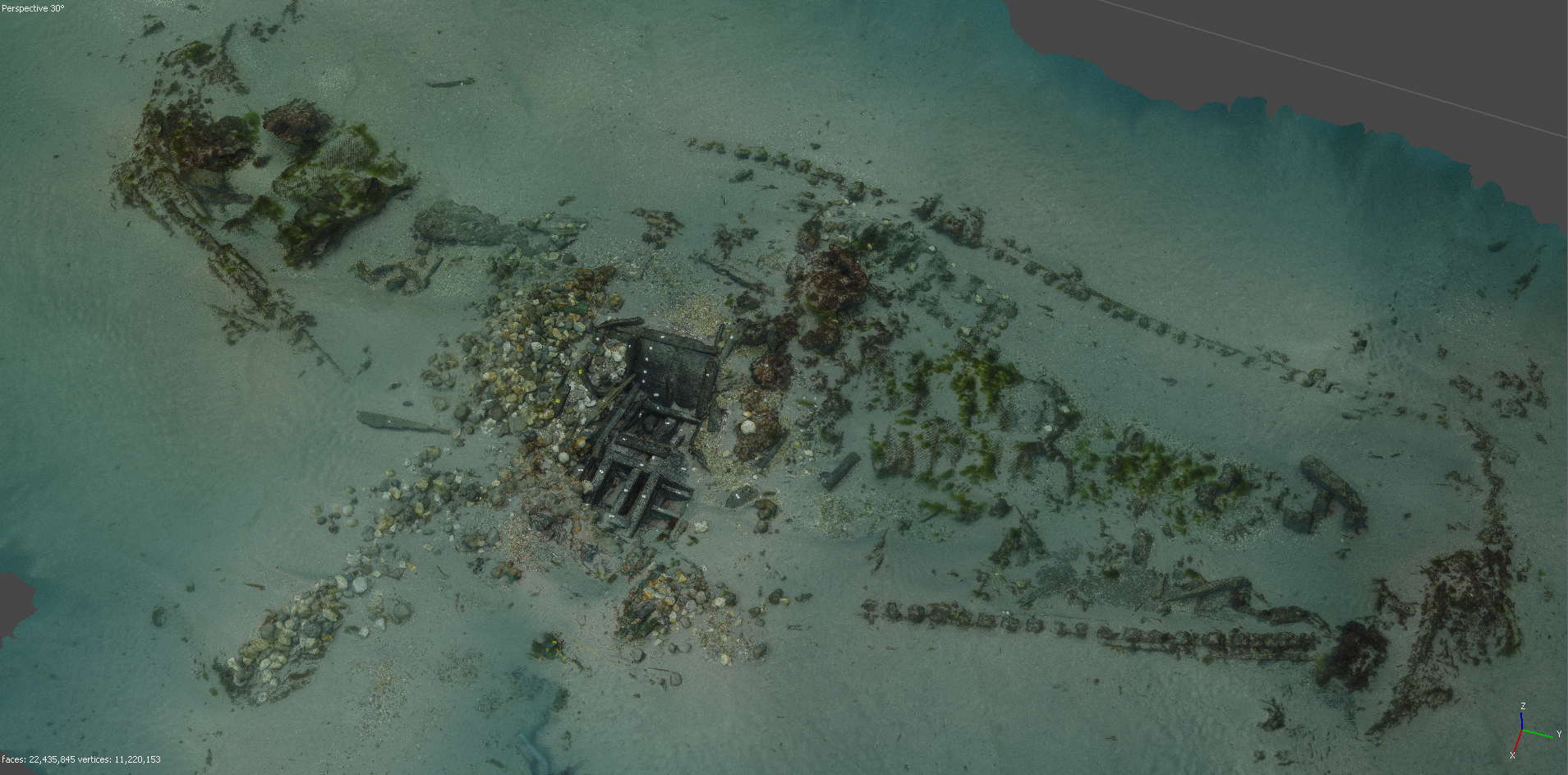
The portion of the bottom exposed was heavily reinforced with twin keelson timbers with very high molded dimensions. Only more extensive excavation, however, will allow us to understand this structure better.
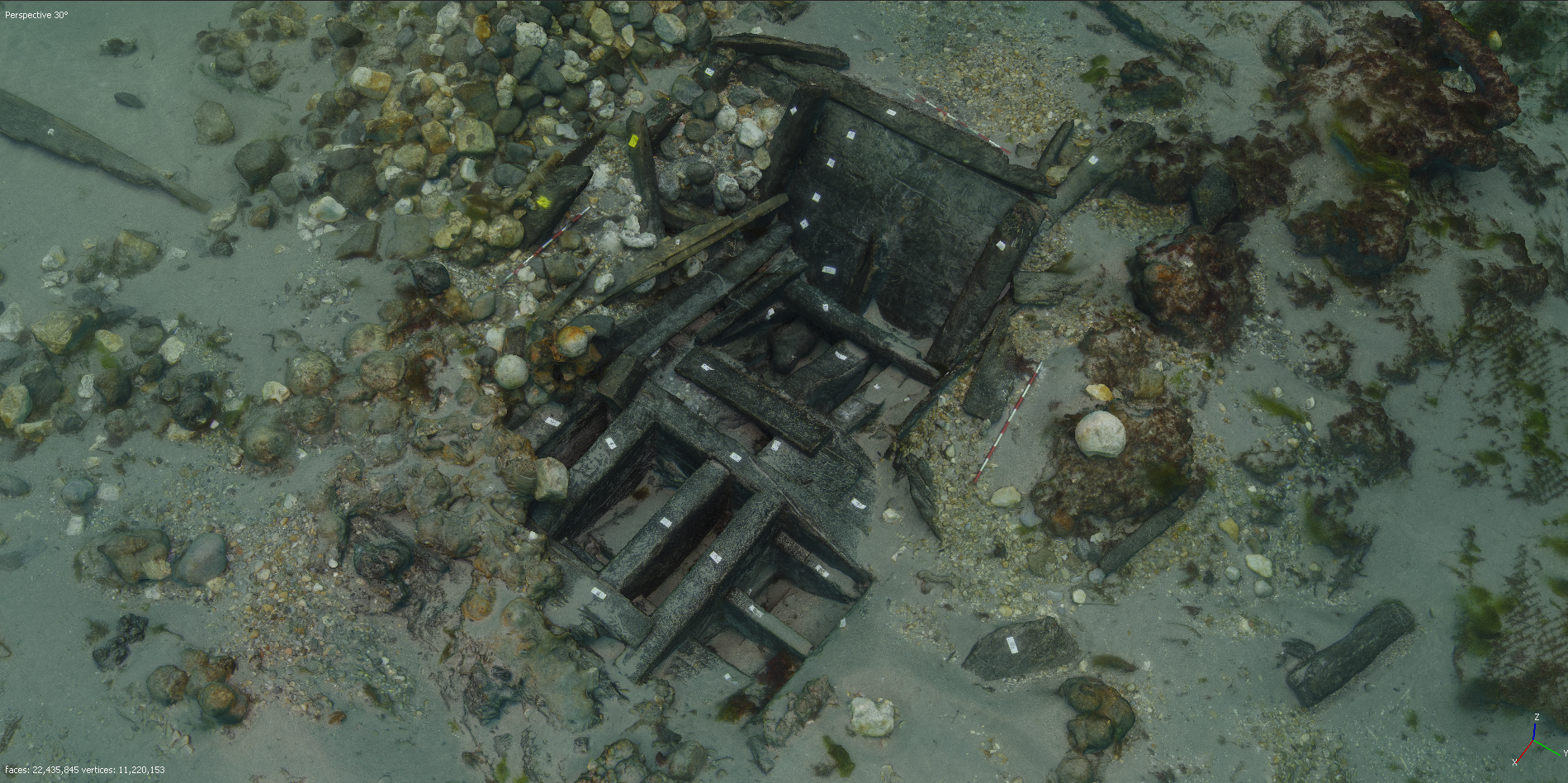
Cargo
We have been careful to avoid expose the cargo, although a large quantity of cannon balls, both stone and iron, have been found allover the center area of the ship. It is likely that a more extensive excavation will reveal the nature of the cargo of a Spanish warship returning from a deployment. The surface, accidental finds, suggest a large number of personal artifacts, from the soldiers and sailors that shared the ship’s space.
Personal Items
There are personal items on this site, such as wooden plates and cups, but we are still working on the artifact catalog.
Rigging
The Ribadeo shipwreck site favors the conservation of organic objects. Fragments of cables are preserved and have been exposed at various points. Some fragments appear loose, while others apparently still remain connected. The diameters of the located remains are around 40 or 50 mm. These sizes indicate that these are cables from the running rigging. A partially buried fragment had a larger diameter, more suitable for use in the ship’s standing rigging or other purpose requiring stronger cables. All cables are made of twisted fibers, without the presence of braided ends.
So far we have only found (2019) a single rigging piece. It is the wheel of a sheave that we have decided to leave in situ until we can guarantee its conservation.
Excavation
We are not excavating the shipwreck yet, but rather opening trenches we can manage and avoiding disturbing artifacts, at least until we have a functioning conservation laboratory staffed all year round.
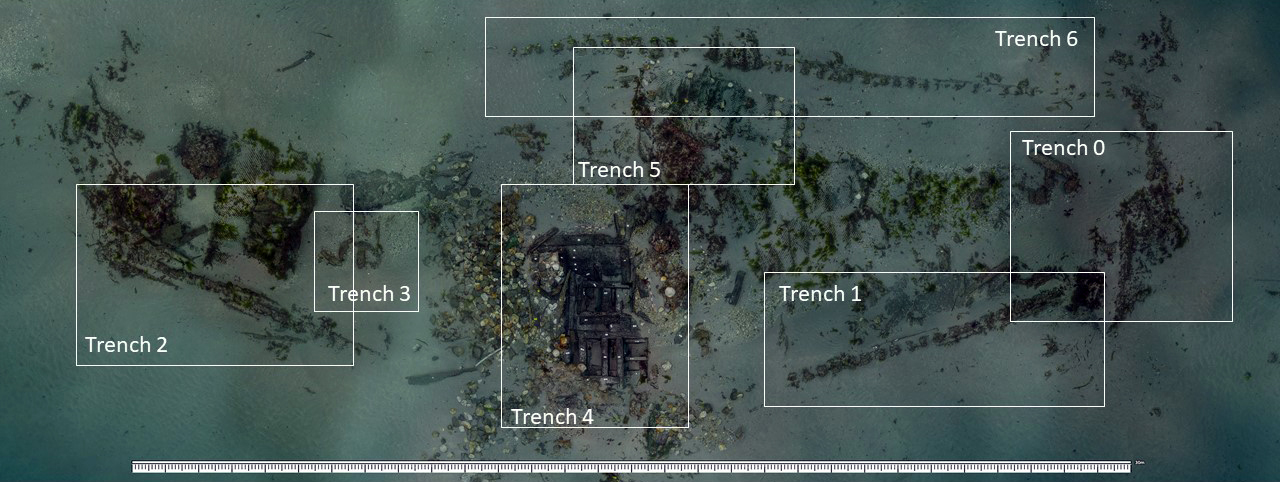
Trench 0
This area was surveyed and trenched in 2015 by Miguel San Claudio. Part of the Stem was uncovered but not recorded in detail.
Trench 1
This area was surveyed and trenched in 2015 by Miguel San Claudio.
Trench 2
This area was trenched in 2014. On the outside the planking is fastened to the frames with iron spikes and the surface is protected with lead sheet.
The inside face was not excavated because of the excellent conservation of the artifacts found in silt, immediately below a thin (c. 10 cm) layer of sand.
Trench 3
Trench 3 was exposed in 2014. Again, the fine silt conserved a large quantity of artifacts and we decided not to excavate this area.
Trench 4
This area was excavated with the expectation that we were in the area of the mast-step. In fact, the mast-step is located in the center of this trench.
Trench 5
This area was only lightly impacted, again because of the quality and quantity of artifacts.
Trench 6
This area was cleaned and the timber tagged, but we only excavated on the thin layer of sand that covers the silt to evaluate the conservation of the timbers. As allover the site, it is exceptional.
Reconstruction
So far only conjectural efforts have been done to reconstruct the ship’s hull from the measurements indicated in historical documents. Caetano Hormaechea, Arnaud Cazenave de la Roche and Raul Palomino have sketched preliminary reconstructions.
Deliverables
We intend this excavation as a public, as participated as possible project. From the first day we have partnered with the local group El Galeón de Ribadeo, el mejor conservado del mundo, a non-profit formed in 2015 to promote the public understanding of this important shipwreck.
We have also kept almost permanent contact with the Ayuntamiento of Ribadeo, and with the media.
A number of videos have been shared on Youtube as well.
ForSEAdiscovery video: http://forseadiscovery.eu/tags/ribadeo-galleon
Publications
Casabán Banaclocha, José Luis. «El pecio de Ribadeo: ¿un galeón mediterráneo?» Espejo de navegantes. 19 de Agosto de 2015. http://abcblogs.abc.es/espejo-de-navegantes/2015/08/19/el-pecio-de-ribadeo-un-galeon-mediterraneo/ (último acceso: 8 de Noviembre de 2015).
Miranda, Benat Eguiluz, 2017. The Galleon of Ribadeo, the dormant colossus from the Age of Discovery that awakens…, in https://forseadiscovery.wordpress.com/the-galleon-of-ribadeo-the-dormant-colossus-from-the-age-of-discovery-that-awakens/
San Claudio, Miguel, 2018. Memoria. Sondaxes sobre o pecio do galeón ragusano San Giacomo di Galizia. Ribadeo, Lugo. Xunta de Galicia.
San Claudio, Miguel, 2015. The Armadas’ Wars in the Iberian Northern Atlantic, a chance for ForSEAdiscovery project. En The Management of Iberian forest resources in the early modern ship building: History and Archaeology. Instituto de Arqueologia e Paleociencias, Universidade Nova de Lisboa. Lisboa.
San Claudio, Miguel, Raúl González, José Luis Casabán, Filipe Castro, y Marta Domínguez. «El pecio de Ribadeo, un excepcionalmente bien conservado pecio español del siglo XVI.» Actas I Congreso de Arqueología Náutica y subacuática española. Cartagena: Ministerio de Cultura, 2014. 208-221.
